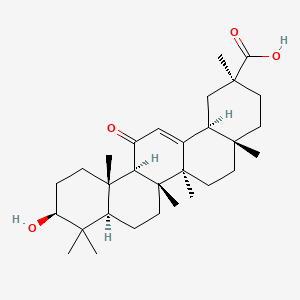| Authors | Title | Published | Journal | PubMed Link |
|---|---|---|---|---|
| Bannerman P et al. | Early migratory rat neural crest cells express functional gap junctions: evidence that neural crest cell survival requires gap junction function. | 2000 | J. Neurosci. Res. | pmid:10972957 |
| Sasaki H et al. | 18β-glycyrrhetinic acid inhibits periodontitis via glucocorticoid-independent nuclear factor-κB inactivation in interleukin-10-deficient mice. | 2010 | J. Periodont. Res. | pmid:20682015 |
| Lallemand B et al. | Synthesis and plasma pharmacokinetics in CD-1 mice of a 18β-glycyrrhetinic acid derivative displaying anti-cancer activity. | 2013 | J. Pharm. Pharmacol. | pmid:23356849 |
| Geddawy A et al. | Mechanism underlying endothelium-dependent relaxation by 2-methylthio-ADP in monkey cerebral artery. | 2010 | J. Pharmacol. Sci. | pmid:20838025 |
| Fujiwara H et al. | Endothelium-derived relaxing factor-mediated vasodilation in mouse mesenteric vascular beds. | 2012 | J. Pharmacol. Sci. | pmid:22450195 |
| Chaytor AT et al. | The endothelial component of cannabinoid-induced relaxation in rabbit mesenteric artery depends on gap junctional communication. | 1999 | J. Physiol. (Lond.) | pmid:10523421 |
| Li WC et al. | Locomotor rhythm maintenance: electrical coupling among premotor excitatory interneurons in the brainstem and spinal cord of young Xenopus tadpoles. | 2009 | J. Physiol. (Lond.) | pmid:19221124 |
| Lang RJ et al. | Spontaneous electrical and Ca2+ signals in typical and atypical smooth muscle cells and interstitial cell of Cajal-like cells of mouse renal pelvis. | 2007 | J. Physiol. (Lond.) | pmid:17656432 |
| Miguel-Hidalgo J et al. | Infusion of gliotoxins or a gap junction blocker in the prelimbic cortex increases alcohol preference in Wistar rats. | 2009 | J. Psychopharmacol. (Oxford) | pmid:18562436 |
| Autsavapromporn N et al. | Intercellular communication amplifies stressful effects in high-charge, high-energy (HZE) particle-irradiated human cells. | 2011 | J. Radiat. Res. | pmid:21905305 |
18alpha-glycyrrhetinic acid
18alpha-glycyrrhetinic acid is a lipid of Prenol Lipids (PR) class. 18alpha-glycyrrhetinic acid is associated with abnormalities such as Wiskott-Aldrich Syndrome. The involved functions are known as inhibitors, salivary gland development and branching morphogenesis.
Cross Reference
Introduction
To understand associated biological information of 18alpha-glycyrrhetinic acid, we collected biological information of abnormalities, associated pathways, cellular/molecular locations, biological functions, related genes/proteins, lipids and common seen animal/experimental models with organized paragraphs from literatures.
What diseases are associated with 18alpha-glycyrrhetinic acid?
18alpha-glycyrrhetinic acid is suspected in and other diseases in descending order of the highest number of associated sentences.
Related references are mostly published in these journals:
| Disease | Cross reference | Weighted score | Related literature |
|---|
No disease MeSH terms mapped to the current reference collection.
PubChem Associated disorders and diseases
What pathways are associated with 18alpha-glycyrrhetinic acid
There are no associated biomedical information in the current reference collection.
PubChem Biomolecular Interactions and Pathways
Link to PubChem Biomolecular Interactions and PathwaysWhat cellular locations are associated with 18alpha-glycyrrhetinic acid?
There are no associated biomedical information in the current reference collection.
What functions are associated with 18alpha-glycyrrhetinic acid?
Related references are published most in these journals:
| Function | Cross reference | Weighted score | Related literatures |
|---|
What lipids are associated with 18alpha-glycyrrhetinic acid?
There are no associated biomedical information in the current reference collection.
What genes are associated with 18alpha-glycyrrhetinic acid?
There are no associated biomedical information in the current reference collection.
What common seen animal models are associated with 18alpha-glycyrrhetinic acid?
There are no associated biomedical information in the current reference collection.
